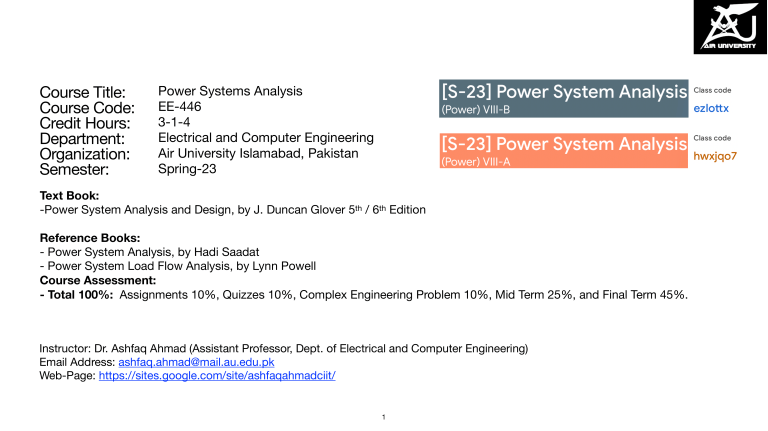
Course Title: Course Code: Credit Hours: Department: Organization: Semester: Power Systems Analysis EE-446 3-1-4 Electrical and Computer Engineering Air University Islamabad, Pakistan Spring-23 Text Book: -Power System Analysis and Design, by J. Duncan Glover 5th / 6th Edition Reference Books: - Power System Analysis, by Hadi Saadat - Power System Load Flow Analysis, by Lynn Powell Course Assessment: - Total 100%: Assignments 10%, Quizzes 10%, Complex Engineering Problem 10%, Mid Term 25%, and Final Term 45%. Instructor: Dr. Ashfaq Ahmad (Assistant Professor, Dept. of Electrical and Computer Engineering) Email Address: ashfaq.ahmad@mail.au.edu.pk Web-Page: https://sites.google.com/site/ashfaqahmadciit/ 1 2 3 Lecture 01: Introduction to Power System Analysis Content Covered: • What is power system analysis? • Motivation— why do we need analysis of power systems? • When do we need power system analysis? • How to perform power system analysis? • Historical background— power system • Pakistan’s electricity sector 4 Lecture 01: Introduction to Power System Analysis What is power system analysis? • Application of mathematics to power systems (think of circuit analysis). - Aim: to determine the state of power system components. Voltage Generators Current Lines Power Transformers Loads • Example: consider a purely resistive line denoted by R=10 Ω. If 100 V is applied across R, determine the following: - Current owing through the line? - Power loss? - Power transfer? Required ratings for safe operations of the component— no burnout? fl 5 Lecture 01: Introduction to Power System Analysis Why do we need analysis of the power system? • To check whether the power system components are operating (or will operate) within certain limits. Voltage limits Current limits Power limits } Avoid excessive violations (deviations) - Quality-of-Service (QoS) - Safety in system operations When do we need power system analysis? • • • • Before building a new power system. Integration of new components with the existing power system. Upgradation of existing power system components. Analysis of contingencies and/or transients in power system. 6 Lecture 01: Introduction to Power System Analysis How to perform power system analysis? • Perform calculations for power system variables in two states. Steady state - Tools - Based on timescales of interest - PSSE - PSCAD - Simscape Power Systems (MATLAB-Simulink) 7 Transient state Lecture 01: Introduction to Power System Analysis History of electric power system [1882] rst power station in New York employing - DC generator driven via steam engines - Total load (lighting only) of 30 kW @ 110 V - DC motor invented and increased attractiveness of the DC system - DC voltage level transformation in not easy— obstacle to power transmission over longer distances [1885] invention of AC transformer - Solution to power transmission over longer distances and capability to serve more loads. [1885/6] William Stanley developed commercially practical transformer [1888] AC motor invented by Nicola Tesla [1889] rst AC power line in Oregon, USA - Two 300 hp waterwheel turbines — transmitted @ 4 kV to Portland [1893] the rst three-phase system @ 2.3 kV Recall: two main operating frequencies worldwide (50 Hz and 60 Hz)! fi fi fi 8 Lecture 01: Introduction to Power System Analysis History of electric power system 9 Lecture 01: Introduction to Power System Analysis Pakistan’s electricity sector • Two vertically integrated public sector companies. - WAPDA: for all Pakistan except Karachi. - K-electric: for Karachi and its surrounding areas. • As of June 2020: - Installed capacity of 37,402 MW as of June 2020. - Maximum total demand of nearly 25,000 MW. - Transmission and distribution capacity is stalled at approximately 22,000 MW. 10



